Maximilian Bernhard
CaRaFFusion: Improving 2D Semantic Segmentation with Camera-Radar Point Cloud Fusion and Zero-Shot Image Inpainting
May 06, 2025Abstract:Segmenting objects in an environment is a crucial task for autonomous driving and robotics, as it enables a better understanding of the surroundings of each agent. Although camera sensors provide rich visual details, they are vulnerable to adverse weather conditions. In contrast, radar sensors remain robust under such conditions, but often produce sparse and noisy data. Therefore, a promising approach is to fuse information from both sensors. In this work, we propose a novel framework to enhance camera-only baselines by integrating a diffusion model into a camera-radar fusion architecture. We leverage radar point features to create pseudo-masks using the Segment-Anything model, treating the projected radar points as point prompts. Additionally, we propose a noise reduction unit to denoise these pseudo-masks, which are further used to generate inpainted images that complete the missing information in the original images. Our method improves the camera-only segmentation baseline by 2.63% in mIoU and enhances our camera-radar fusion architecture by 1.48% in mIoU on the Waterscenes dataset. This demonstrates the effectiveness of our approach for semantic segmentation using camera-radar fusion under adverse weather conditions.
Autoregressive Policy Optimization for Constrained Allocation Tasks
Sep 27, 2024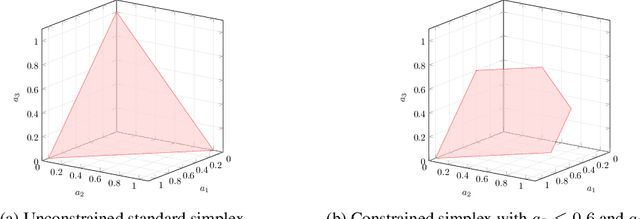
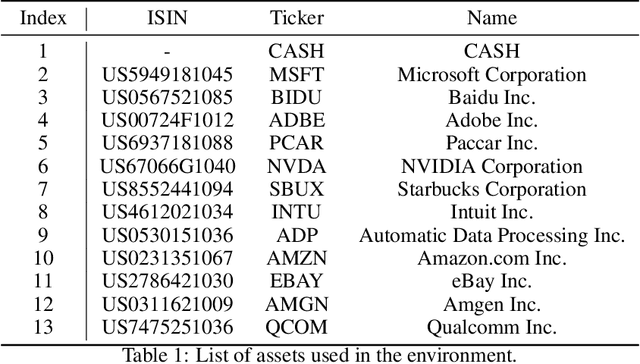
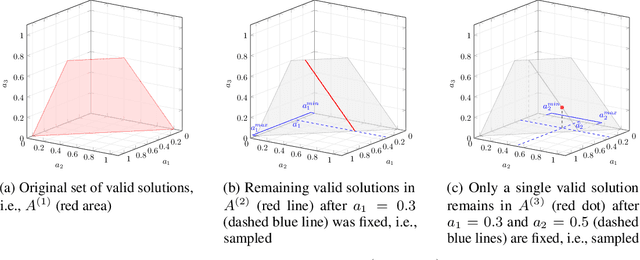
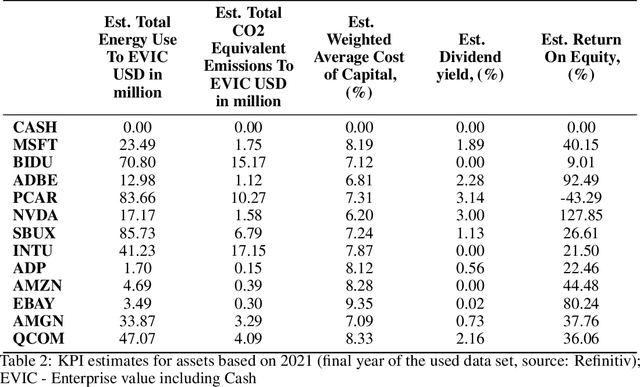
Abstract:Allocation tasks represent a class of problems where a limited amount of resources must be allocated to a set of entities at each time step. Prominent examples of this task include portfolio optimization or distributing computational workloads across servers. Allocation tasks are typically bound by linear constraints describing practical requirements that have to be strictly fulfilled at all times. In portfolio optimization, for example, investors may be obligated to allocate less than 30\% of the funds into a certain industrial sector in any investment period. Such constraints restrict the action space of allowed allocations in intricate ways, which makes learning a policy that avoids constraint violations difficult. In this paper, we propose a new method for constrained allocation tasks based on an autoregressive process to sequentially sample allocations for each entity. In addition, we introduce a novel de-biasing mechanism to counter the initial bias caused by sequential sampling. We demonstrate the superior performance of our approach compared to a variety of Constrained Reinforcement Learning (CRL) methods on three distinct constrained allocation tasks: portfolio optimization, computational workload distribution, and a synthetic allocation benchmark. Our code is available at: https://github.com/niklasdbs/paspo
Context Matters: Leveraging Spatiotemporal Metadata for Semi-Supervised Learning on Remote Sensing Images
Apr 29, 2024Abstract:Remote sensing projects typically generate large amounts of imagery that can be used to train powerful deep neural networks. However, the amount of labeled images is often small, as remote sensing applications generally require expert labelers. Thus, semi-supervised learning (SSL), i.e., learning with a small pool of labeled and a larger pool of unlabeled data, is particularly useful in this domain. Current SSL approaches generate pseudo-labels from model predictions for unlabeled samples. As the quality of these pseudo-labels is crucial for performance, utilizing additional information to improve pseudo-label quality yields a promising direction. For remote sensing images, geolocation and recording time are generally available and provide a valuable source of information as semantic concepts, such as land cover, are highly dependent on spatiotemporal context, e.g., due to seasonal effects and vegetation zones. In this paper, we propose to exploit spatiotemporal metainformation in SSL to improve the quality of pseudo-labels and, therefore, the final model performance. We show that directly adding the available metadata to the input of the predictor at test time degenerates the prediction quality for metadata outside the spatiotemporal distribution of the training set. Thus, we propose a teacher-student SSL framework where only the teacher network uses metainformation to improve the quality of pseudo-labels on the training set. Correspondingly, our student network benefits from the improved pseudo-labels but does not receive metadata as input, making it invariant to spatiotemporal shifts at test time. Furthermore, we propose methods for encoding and injecting spatiotemporal information into the model and introduce a novel distillation mechanism to enhance the knowledge transfer between teacher and student. Our framework dubbed Spatiotemporal SSL can be easily combined with several stat...
GRAtt-VIS: Gated Residual Attention for Auto Rectifying Video Instance Segmentation
May 26, 2023Abstract:Recent trends in Video Instance Segmentation (VIS) have seen a growing reliance on online methods to model complex and lengthy video sequences. However, the degradation of representation and noise accumulation of the online methods, especially during occlusion and abrupt changes, pose substantial challenges. Transformer-based query propagation provides promising directions at the cost of quadratic memory attention. However, they are susceptible to the degradation of instance features due to the above-mentioned challenges and suffer from cascading effects. The detection and rectification of such errors remain largely underexplored. To this end, we introduce \textbf{GRAtt-VIS}, \textbf{G}ated \textbf{R}esidual \textbf{Att}ention for \textbf{V}ideo \textbf{I}nstance \textbf{S}egmentation. Firstly, we leverage a Gumbel-Softmax-based gate to detect possible errors in the current frame. Next, based on the gate activation, we rectify degraded features from its past representation. Such a residual configuration alleviates the need for dedicated memory and provides a continuous stream of relevant instance features. Secondly, we propose a novel inter-instance interaction using gate activation as a mask for self-attention. This masking strategy dynamically restricts the unrepresentative instance queries in the self-attention and preserves vital information for long-term tracking. We refer to this novel combination of Gated Residual Connection and Masked Self-Attention as \textbf{GRAtt} block, which can easily be integrated into the existing propagation-based framework. Further, GRAtt blocks significantly reduce the attention overhead and simplify dynamic temporal modeling. GRAtt-VIS achieves state-of-the-art performance on YouTube-VIS and the highly challenging OVIS dataset, significantly improving over previous methods. Code is available at \url{https://github.com/Tanveer81/GRAttVIS}.
MapFormer: Boosting Change Detection by Using Pre-change Information
Mar 31, 2023
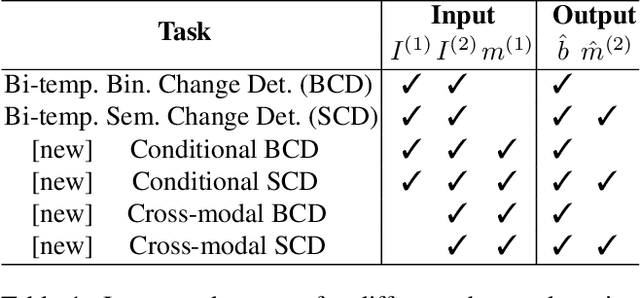

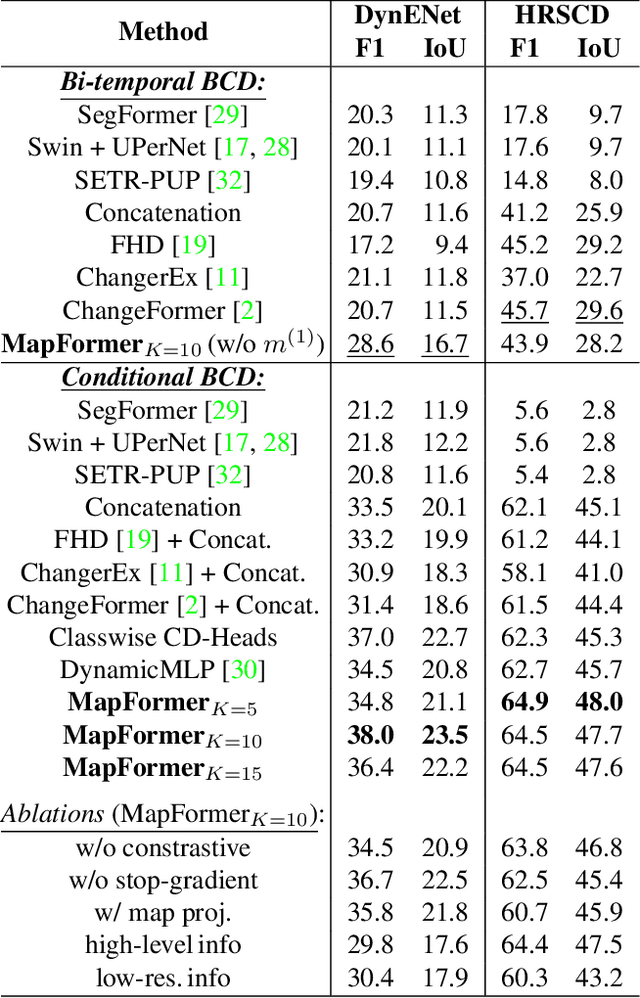
Abstract:Change detection in remote sensing imagery is essential for a variety of applications such as urban planning, disaster management, and climate research. However, existing methods for identifying semantically changed areas overlook the availability of semantic information in the form of existing maps describing features of the earth's surface. In this paper, we leverage this information for change detection in bi-temporal images. We show that the simple integration of the additional information via concatenation of latent representations suffices to significantly outperform state-of-the-art change detection methods. Motivated by this observation, we propose the new task of Conditional Change Detection, where pre-change semantic information is used as input next to bi-temporal images. To fully exploit the extra information, we propose MapFormer, a novel architecture based on a multi-modal feature fusion module that allows for feature processing conditioned on the available semantic information. We further employ a supervised, cross-modal contrastive loss to guide the learning of visual representations. Our approach outperforms existing change detection methods by an absolute 11.7% and 18.4% in terms of binary change IoU on DynamicEarthNet and HRSCD, respectively. Furthermore, we demonstrate the robustness of our approach to the quality of the pre-change semantic information and the absence pre-change imagery. The code will be made publicly available.
Robust Object Detection in Remote Sensing Imagery with Noisy and Sparse Geo-Annotations (Full Version)
Oct 24, 2022


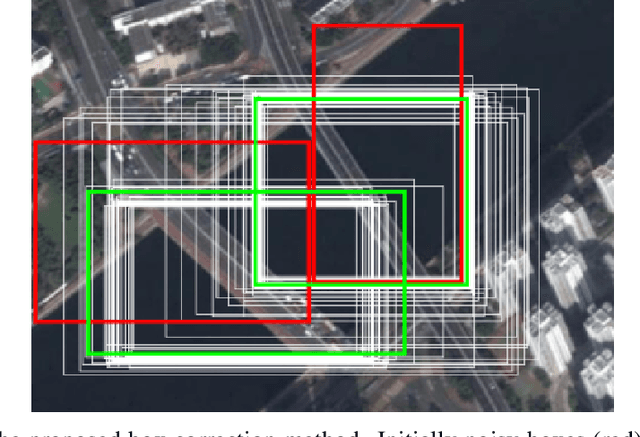
Abstract:Recently, the availability of remote sensing imagery from aerial vehicles and satellites constantly improved. For an automated interpretation of such data, deep-learning-based object detectors achieve state-of-the-art performance. However, established object detectors require complete, precise, and correct bounding box annotations for training. In order to create the necessary training annotations for object detectors, imagery can be georeferenced and combined with data from other sources, such as points of interest localized by GPS sensors. Unfortunately, this combination often leads to poor object localization and missing annotations. Therefore, training object detectors with such data often results in insufficient detection performance. In this paper, we present a novel approach for training object detectors with extremely noisy and incomplete annotations. Our method is based on a teacher-student learning framework and a correction module accounting for imprecise and missing annotations. Thus, our method is easy to use and can be combined with arbitrary object detectors. We demonstrate that our approach improves standard detectors by 37.1\% $AP_{50}$ on a noisy real-world remote-sensing dataset. Furthermore, our method achieves great performance gains on two datasets with synthetic noise. Code is available at \url{https://github.com/mxbh/robust_object_detection}.
 Add to Chrome
Add to Chrome Add to Firefox
Add to Firefox Add to Edge
Add to Edge